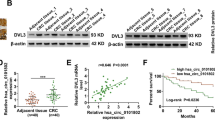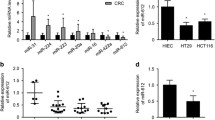Abstract
Purpose
Colorectal cancer (CRC) is a severe health condition characterized by high mortalities. NudC domain containing 1 (NUDCD1) is abnormally upregulated in multiple tumors and is recognized as a cancer antigen. In CRC, NUDCD1 upregulation accelerates tumor progression by activating the IGF1R-ERK1/2 signaling pathway. Its specific regulatory mechanisms, however, remain unclear.
Methods
In the present study, we predicted the regulators of NUDCD1 and analyzed the expression profile of NUDCD1 in CRC tissues using the gene chip dataset. We also determined the regulation between miR-144, NUDCD1 and IGF1R-ERK1/2 signaling in vitro and in vivo. Then, the expression of miR-144 in CRC tissues was detected and its cell functions were verified in vitro.
Results
As predicted by bioinformatics, we found that NUDCD1 is a predicted target of miR-144 and confirmed that miR-144 directly binds to NUDCD1. In vitro and in vivo, miR-144 was determined to specifically regulate NUDCD1 expression and as such, can reduce the activity of the IGF1R-ERK1/2 signaling pathway. Moreover, miR-144 was significantly downregulated in CRC tissues; its levels were significantly negatively correlated with CRC primary range and lymph node metastasis. Cell function studies verified that miR-144 acts as a tumor suppressor, because it significantly inhibits the proliferation, metastasis, and invasion of CRC cells as well as inducing cell cycle arrest and apoptosis.
Conclusions
Our study demonstrates that miR-144 regulates IGF1R-ERK1/2 signaling via NUDCD1 to inhibit CRC cell proliferation and metastasis. The miR-144/NUDCD1/IGF1R-ERK1/2 signaling axis may be crucial in the progression of CRC.







Similar content being viewed by others
Data availability
The datasets generated during and/or analysed during the current study are available from the corresponding author on reasonable request.
References
Asselin-Mullen P, Chauvin A, Dubois ML, Drissi R, Levesque D, Boisvert FM (2017) Protein interaction network of alternatively spliced NudCD1 isoforms. Sci Rep 7:12987. https://doi.org/10.1038/s41598-017-13441-w
Bartel DP (2009) MicroRNAs: target recognition and regulatory functions. Cell 136:215–233. https://doi.org/10.1016/j.cell.2009.01.002
Bray F, Ferlay J, Soerjomataram I, Siegel RL, Torre LA, Jemal A (2018) Global cancer statistics 2018: GLOBOCAN estimates of incidence and mortality worldwide for 36 cancers in 185 countries. CA Cancer J Clin 68:394–424. https://doi.org/10.3322/caac.21492
Brenner H, Kloor M, Pox CP (2014) Colorectal Cancer. Lancet 383:1490–1502. https://doi.org/10.1016/S0140-6736(13)61649-9
Brodersen P, Voinnet O (2009) Revisiting the principles of microRNA target recognition and mode of action. Nat Rev Mol Cell Biol 10:141–148. https://doi.org/10.1038/nrm2619
Cao ZQ, Wang Z, Leng P (2019) Aberrant N-cadherin expression in cancer. Biomed Pharmacother 118:109320. https://doi.org/10.1016/j.biopha.2019.109320
Cao HL, Gu MQ, Sun Z, Chen ZJ (2020) miR-144-3p contributes to the development of thyroid tumors through the PTEN/PI3K/AKT pathway. Cancer Manag Res 12:9845–9855. https://doi.org/10.2147/CMAR.S265196
Chen W et al (2016) Cancer statistics in China, 2015. CA Cancer J Clin 66:115–132. https://doi.org/10.3322/caac.21338
Chen G et al (2018) Lico A causes er stress and apoptosis via up-regulating miR-144-3p in human lung cancer cell line H292. Front Pharmacol 9:837. https://doi.org/10.3389/fphar.2018.00837
Cheng B, Zhang Y, Wu ZW, Cui ZC, Li WL (2020) MiR-144 inhibits colorectal cancer cell migration and invasion by regulating PBX3. Eur Rev Med Pharmacol Sci 24:9361–9369. https://doi.org/10.26355/eurrev_202009_23019
Davis MI et al (2016) Small molecule inhibition of the ubiquitin-specific protease USP2 accelerates cyclin D1 degradation and leads to cell cycle arrest in colorectal cancer and mantle cell lymphoma models. J Biol Chem 291:24628–24640. https://doi.org/10.1074/jbc.M116.738567
Dino P, D’Anna C, Sangiorgi C, Di Sano C, Di Vincenzo S, Ferraro M, Pace E (2019) Cigarette smoke extract modulates E-cadherin, claudin-1 and miR-21 and promotes cancer invasiveness in human colorectal adenocarcinoma cells. Toxicol Lett 317:102–109. https://doi.org/10.1016/j.toxlet.2019.09.020
Dweep H, Sticht C, Pandey P, Gretz N (2011) miRWalk–database: prediction of possible miRNA binding sites by “walking” the genes of three genomes. J Biomed Inform 44:839–847. https://doi.org/10.1016/j.jbi.2011.05.002
Fonseka P, Pathan M, Chitti SV, Kang T, Mathivanan S (2020) FunRich enables enrichment analysis of OMICs datasets. J Mol Biol. https://doi.org/10.1016/j.jmb.2020.166747
Gao Z, Liu R, Liao J, Yang M, Pan E, Yin L, Pu Y (2016) Possible tumor suppressive role of the miR-144/451 cluster in esophageal carcinoma as determined by principal component regression analysis. Mol Med Rep 14:3805–3813. https://doi.org/10.3892/mmr.2016.5691
Goodall GJ, Wickramasinghe VO (2021) RNA in cancer. Nat Rev Cancer 21:22–36. https://doi.org/10.1038/s41568-020-00306-0
Gu YY et al (2018) Matrine induces apoptosis in multiple colorectal cancer cell lines in vitro and inhibits tumour growth with minimum side effects in vivo via Bcl-2 and caspase-3. Phytomedicine 51:214–225. https://doi.org/10.1016/j.phymed.2018.10.004
Guo W et al (2015) MiR-199a-5p is negatively associated with malignancies and regulates glycolysis and lactate production by targeting hexokinase 2 in liver cancer. Hepatology 62:1132–1144. https://doi.org/10.1002/hep.27929
Han B et al (2018a) MicroRNA-144 mediates chronic inflammation and tumorigenesis in colorectal cancer progression via regulating C-X-C motif chemokine ligand 11. Exp Ther Med 16:1935–1943. https://doi.org/10.3892/etm.2018a.6389
Han B et al (2018b) NUDCD1 promotes metastasis through inducing EMT and inhibiting apoptosis in colorectal cancer. Am J Cancer Res 8:810–823
He B, Xia S, Zhang Z (2020a) NudCD1 promotes the proliferation and metastasis of non-small cell lung cancer cells through the activation of IGF1R-ERK1/2. Pathobiology 87:244–253. https://doi.org/10.1159/000505159
He L, Liao L, Du L (2020b) miR1443p inhibits tumor cell growth and invasion in oral squamous cell carcinoma through the downregulation of the oncogenic gene, EZH2. Int J Mol Med 46:828–838. https://doi.org/10.3892/ijmm.2020.4638
Hu Y et al (2018) Epigenetic suppression of E-cadherin expression by Snail2 during the metastasis of colorectal cancer. Clin Epigenet 10:154. https://doi.org/10.1186/s13148-018-0592-y
Huo F, Zhang C, He H, Wang Y (2016) MicroRNA-144-3p inhibits proliferation and induces apoptosis of human salivary adenoid carcinoma cells via targeting of mTOR. Biotechnol Lett 38:409–416. https://doi.org/10.1007/s10529-015-2007-x
Iwaya T et al (2012) Downregulation of miR-144 is associated with colorectal cancer progression via activation of mTOR signaling pathway. Carcinogenesis 33:2391–2397. https://doi.org/10.1093/carcin/bgs288
Ji X et al (2019) miR-144 suppresses cell proliferation and migration in colorectal cancer by targeting NRAS. J Cell Biochem. https://doi.org/10.1002/jcb.29543
Jiang X et al (2015) miR-144/451 promote cell proliferation via targeting PTEN/AKT pathway in insulinomas. Endocrinology 156:2429–2439. https://doi.org/10.1210/en.2014-1966
Jin J, Wang Y, Xu Y, Zhou X, Liu Y, Li X, Wang J (2017) MicroRNA-144 regulates cancer cell proliferation and cell-cycle transition in acute lymphoblastic leukemia through the interaction of FMN2. J Gene Med. https://doi.org/10.1002/jgm.2898
Kim MJ et al (2020) Novel SIRT inhibitor, MHY2256, induces cell cycle arrest, apoptosis, and autophagic cell death in HCT116 human colorectal cancer cells. Biomol Ther (seoul) 28:561–568. https://doi.org/10.4062/biomolther.2020.153
Kooshkaki O et al (2020) MiR-144: a new possible therapeutic target and diagnostic/prognostic tool in cancers. Int J Mol Sci. https://doi.org/10.3390/ijms21072578
Li J, Sun P, Yue Z, Zhang D, You K, Wang J (2017) miR-144–3p induces cell cycle arrest and apoptosis in pancreatic cancer cells by targeting proline-rich protein 11 expression via the mitogen-activated protein kinase signaling pathway. DNA Cell Biol 36:619–626. https://doi.org/10.1089/dna.2017.3656
Liu F, Chen N, Xiao R, Wang W, Pan Z (2016) miR-144–3p serves as a tumor suppressor for renal cell carcinoma and inhibits its invasion and metastasis by targeting MAP3K8. Biochem Biophys Res Commun 480:87–93. https://doi.org/10.1016/j.bbrc.2016.10.004
Liu JL et al (2019) MiR-144 inhibits tumor growth and metastasis in osteosarcoma via dual-suppressing RhoA/ROCK1 signaling pathway. Mol Pharmacol 95:451–461. https://doi.org/10.1124/mol.118.114207
Livak KJ, Schmittgen TD (2001) Analysis of relative gene expression data using real-time quantitative PCR and the 2(-delta delta C(T)) method. Methods 25:402–408. https://doi.org/10.1006/meth.2001.1262
Nagy A, Lanczky A, Menyhart O, Gyorffy B (2018) Validation of miRNA prognostic power in hepatocellular carcinoma using expression data of independent datasets. Sci Rep 8:9227. https://doi.org/10.1038/s41598-018-27521-y
Ovcharenko D, Kelnar K, Johnson C, Leng N, Brown D (2007) Genome-scale microRNA and small interfering RNA screens identify small RNA modulators of TRAIL-induced apoptosis pathway. Cancer Res 67:10782–10788. https://doi.org/10.1158/0008-5472.CAN-07-1484
Padmanaban V, Krol I, Suhail Y, Szczerba BM, Aceto N, Bader JS, Ewald AJ (2019) E-cadherin is required for metastasis in multiple models of breast cancer. Nature 573:439–444. https://doi.org/10.1038/s41586-019-1526-3
Rao W et al (2014a) OVA66 increases cell growth, invasion and survival via regulation of IGF-1R-MAPK signaling in human cancer cells. Carcinogenesis 35:1573–1581. https://doi.org/10.1093/carcin/bgu070
Rao W et al (2014b) OVA66, a tumor associated protein, induces oncogenic transformation of NIH3T3 cells. PLoS ONE 9:e85705. https://doi.org/10.1371/journal.pone.0085705
Rasmussen KD et al (2010) The miR-144/451 locus is required for erythroid homeostasis. J Exp Med 207:1351–1358. https://doi.org/10.1084/jem.20100458
Roskoski R Jr (2012) ERK1/2 MAP kinases: structure, function, and regulation. Pharmacol Res 66:105–143. https://doi.org/10.1016/j.phrs.2012.04.005
Roskoski R Jr (2019) Targeting ERK1/2 protein-serine/threonine kinases in human cancers. Pharmacol Res 142:151–168. https://doi.org/10.1016/j.phrs.2019.01.039
Shi C et al (2021) NUDCD1 knockdown inhibits the proliferation, migration, and invasion of pancreatic cancer via the EMT process. Aging (albany NY) 13:18298–18309. https://doi.org/10.18632/aging.203276
Sheng S, Xie L, Wu Y, Ding M, Zhang T, Wang X (2019) MiR-144 inhibits growth and metastasis in colon cancer by down-regulating SMAD4. Biosci Rep. https://doi.org/10.1042/BSR20181895
Song F, Chen Q, Rao W, Zhang R, Wang Y, Ge H, Wei Q (2019) OVA66 promotes tumour angiogenesis and progression through enhancing autocrine VEGF-VEGFR2 signalling. EBioMedicine 41:156–166. https://doi.org/10.1016/j.ebiom.2019.02.051
Sun J et al (2017) E2F8, a direct target of miR-144, promotes papillary thyroid cancer progression via regulating cell cycle. J Exp Clin Cancer Res 36:40. https://doi.org/10.1186/s13046-017-0504-6
Sun N, Zhang L, Zhang C, Yuan Y (2020) miR-144-3p inhibits cell proliferation of colorectal cancer cells by targeting BCL6 via inhibition of Wnt/beta-catenin signaling. Cell Mol Biol Lett 25:19. https://doi.org/10.1186/s11658-020-00210-3
Sureban SM et al (2011) Nanoparticle-based delivery of siDCAMKL-1 increases microRNA-144 and inhibits colorectal cancer tumor growth via a Notch-1 dependent mechanism. J Nanobiotechnol 9:40. https://doi.org/10.1186/1477-3155-9-40
Szklarczyk D, Jensen LJ (2015) Protein–protein interaction databases. Methods Mol Biol 1278:39–56. https://doi.org/10.1007/978-1-4939-2425-7_3
Wang Q et al (2008) RNA interference targeting CML66, a novel tumor antigen, inhibits proliferation, invasion and metastasis of HeLa cells. Cancer Lett 269:127–138. https://doi.org/10.1016/j.canlet.2008.04.035
Wang X et al (2012) Loss of the miR-144/451 cluster impairs ischaemic preconditioning-mediated cardioprotection by targeting Rac-1. Cardiovasc Res 94:379–390. https://doi.org/10.1093/cvr/cvs096
Wong NW, Chen Y, Chen S, Wang X (2018) OncomiR: an online resource for exploring pan-cancer microRNA dysregulation. Bioinformatics 34:713–715. https://doi.org/10.1093/bioinformatics/btx627
Zhao S, Xue H, Hao CL, Jiang HM, Zheng HC (2020) BTG1 overexpression might promote invasion and metastasis of colorectal cancer via decreasing adhesion and inducing epithelial-mesenchymal transition. Front Oncol 10:598192. https://doi.org/10.3389/fonc.2020.598192
Zhou S, Ye W, Zhang Y, Yu D, Shao Q, Liang J, Zhang M (2016) miR-144 reverses chemoresistance of hepatocellular carcinoma cell lines by targeting Nrf2-dependent antioxidant pathway. Am J Transl Res 8:2992–3002
Zhou J et al (2019) Antitumor activity in colorectal cancer induced by hinokiflavone. J Gastroenterol Hepatol 34:1571–1580. https://doi.org/10.1111/jgh.14581
Zhou M, Wu Y, Li H, Zha X (2020) MicroRNA-144: a novel biological marker and potential therapeutic target in human solid cancers. J Cancer 11:6716–6726. https://doi.org/10.7150/jca.46293
Acknowledgements
The authors thank Fu Liu, Qiang Ma and Daiyuan Ma for providing valuable technical supports.
Funding
This study was supported by National Natural Science Foundation of China (819θ3660); Sichuan Science and Technology Plan Project (2019YJ0386); Sichuan Education Plan Project (18ZB0219); Nanchong City and School Cooperation Project (NSMC20170447, 18SXHZ0324, 20SXQT0101); Affiliated Hospital of North Sichuan Medical College Plan Projects (2019ZD005).
Author information
Authors and Affiliations
Contributions
All authors contributed to the study conception and design. Material preparation, data collection and analysis were performed by BH and KX. DF collected the samples and contributed to the design of this study. YB and YL were involved in the animal experiments. The first draft of the manuscript was written by LZ and YZ, all authors commented on previous versions of the manuscript. All authors read and approved the final manuscript.
Corresponding authors
Ethics declarations
Conflict of interest
The authors declare that there are no conflict of interests.
Ethics approval
All procedures performed in studies involving human participants were in accordance with the ethical standards of the institutional committee and with the 1964 Helsinki Declaration and its later amendments or comparable ethical standards.
Additional information
Publisher's Note
Springer Nature remains neutral with regard to jurisdictional claims in published maps and institutional affiliations.
Supplementary Information
Below is the link to the electronic supplementary material.
Rights and permissions
About this article
Cite this article
Han, B., Xu, K., Feng, D. et al. miR-144 inhibits the IGF1R-ERK1/2 signaling pathway via NUDCD1 to suppress the proliferation and metastasis of colorectal cancer cells: a study based on bioinformatics and in vitro and in vivo verification. J Cancer Res Clin Oncol 148, 1903–1918 (2022). https://doi.org/10.1007/s00432-022-03951-0
Received:
Accepted:
Published:
Issue Date:
DOI: https://doi.org/10.1007/s00432-022-03951-0




